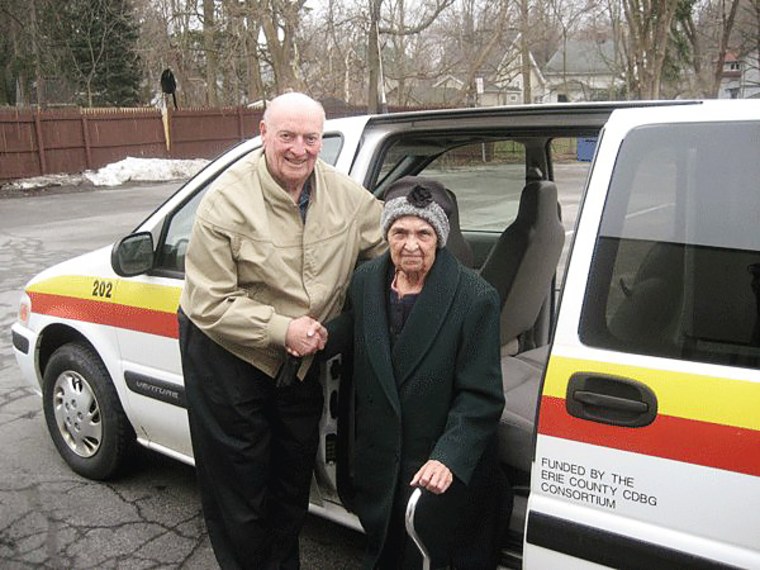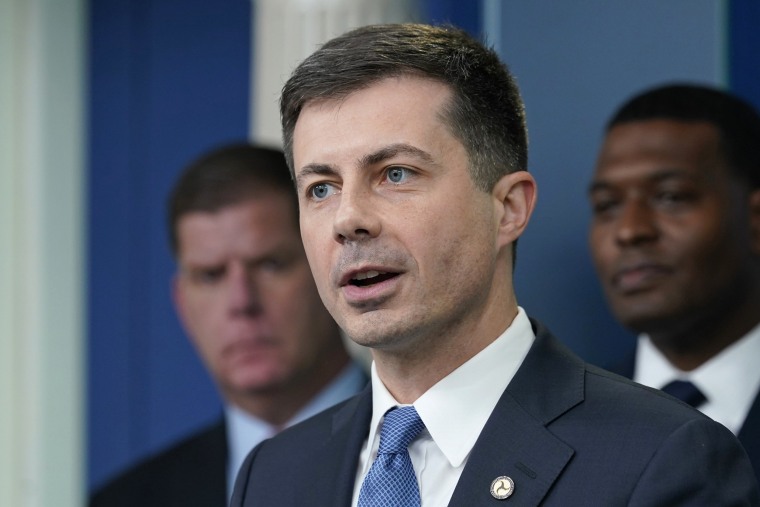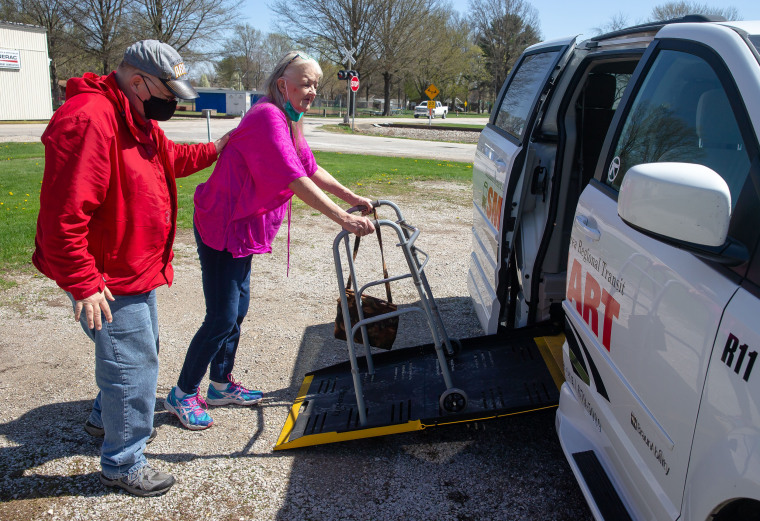Judith Fisher doesn’t want to be that small-town parent nagging her children for rides for everywhere she goes.
The 81-year-old, who resides in rural East Aurora, near Buffalo, New York, hasn’t asked her two children for a ride to the doctor’s office for physical therapy in three months.
She instead relies on the Rural Transit Service, a nonprofit transportation organization focused on driving older adults to dialysis clinics, adult day cares, the dentist and other health-related appointments.
Fisher, who has given up winter driving, said the transportation service has been a lifeline for her and other local transit-reliant residents.
“It’s allowing people to live their lives without asking help from children or neighbors,” Fisher said.
Millions of older adults living in rural America no longer drive and don’t have adequate access to alternative transportation that can assist them with rides to banks, pharmacies and other important places, said Baruch Feigenbaum, senior managing director for transportation policy at the Reason Foundation.
Rural Transit Service, which employs three people but largely relies on its 65 volunteers, is an example of how nonprofit organizations can help address a lingering transit problem among older adults in rural populations, Feigenbaum said.

That idea may soon get a shot in the arm. President Joe Biden’s infrastructure law is set to unlock $2 billion in federal money for various rural transit projects. But it still may not be enough to solve the seemingly intractable problem of inadequate transportation for rural older adults.
“Having additional funding to expand services is always a good thing,” said David Kack, executive director of the Western Transportation Institute at Montana State University. But, Kack said, the “distances involved in rural areas” make it difficult to transform rural transportation.
Monday was the application deadline for the Rural Surface Transportation Grant Program, which will help fund several infrastructure projects nationwide.
The Transportation Department will award up to $300 million in grants this year and $2 billion over the next five years as part of the program.
Some of that funding will likely go to more traditional infrastructure projects like highways and bridges, but unconventional projects like "on-demand mobility services" also are eligible.
Transportation Secretary Pete Buttigieg, speaking to a town hall audience in Indiana last month, said towns will be eligible for innovative transit systems like on-demand service under the grant program.
“We’ve seen great results connecting people to jobs, to doctor’s appointments, to community activities and resources,” he said, citing states such as Vermont and Florida with successful track records using the transit systems.
He didn’t mention how much of the $2 billion could be spent on the systems. Asked how much money could be dedicated for on-demand service, the Transportation Department didn’t specify.

The percentage of people over age 65 and living in rural areas increased nationally from around 16 percent to about 20 percent between 2012 and 2019, according to the Rural Transit Fact Book published earlier this year by the Small Urban and Rural Center on Mobility in the Upper Great Plains Transportation Institute at North Dakota State University.
It was funded by the Western Transportation Institute at Montana State University. Feigenbaum estimated that 3 million to 9 million people are transit-dependent and living in rural places.
Rural populations tend to be older with residents taking fewer but longer trips, the fact book reported. Higher concentrations of older adult populations are found in Florida, the rural Midwest and Great Plains region, and parts of the western U.S., the fact book said.
Many of those older adults can’t physically drive anymore, don’t want to drive or simply can’t afford a private vehicle, meaning they rely on friends or loved ones to get around, according to rural transit experts.
What's more, unlike in large or midsize metropolitan cities where trains, buses and even cabs and Uber run nonstop and have the ability to drop older adults off at or near their preferred destinations, rural America is far less equipped and connected.
“They’re stuck,” Feigenbaum said. “Without rural transit, the only thing they can do is ask someone for a ride or basically walk, which, for many folks who are elderly or disabled, isn’t a viable option.”
One way to make rural transit more accessible for older adults nationwide — including those who are disabled or have low incomes — is to use various forms of federal funding to dole out more grant money for nonprofit organizations like the Rural Transit Service in New York, transportation experts say.
Each year, the organization receives a Community Development Block Grant for $270,000 to pay for vehicles, maintenance and three employees, said Suni Stachura, the executive director.
“We only operate in towns and municipalities that do not have mass transit,” she said, adding that the priority is to provide medical transportation for clients across 25 towns. “Our goal is to get people back out in the community using health services.”
Feigenbaum called the nonprofit the national model for what an organization can do with the right resources. Federal funding for such programs and those that offer low-cost, Uber-type services, he said, could help alleviate rural transit woes for older people, if the funds are properly spent.
“It depends on how the money is used. We’re very good at spending a lot of money and not getting a lot of results,” Feigenbaum said. “It can go a long way.”
He said not only does enough funding need to be made available, but success is also tied to how the transit entity, whether a nonprofit organization or a private transit agency, executes the funding. “If there are no detailed metrics involved, then it will be really easy for this funding to be wasted,” Feigenbaum said.
Several cities in rural areas already have some version of on-demand transit service.
Earlier this month, the Capital Area Rural Transportation System, a van transit service, launched in Lockhart, Texas, a city of 14,000 people about 35 miles from Austin. Van rides anywhere within city limits cost up to $2.
In Valdosta, Georgia, a similar transit service became the city’s first transportation system last year after using a $1 million grant from the Federal Transit Administration to lease seven vans.
Meanwhile, Gainesville, Georgia, used a $1 million FTA grant to jumpstart its WeGo transit van system, which takes passengers on rides throughout rural Hall County.
The mayors of Gainesville and Valdosta say the transit systems have far exceeded expectations, with both systems operating at max capacity.
Valdosta On-Demand vehicles make 300 trips per day on average. WeGo’s fleet of 17 vehicles conducted 80,000 trips during its inaugural year.
But the services aren't perfect. They operate for only about 12 hours per day Monday through Friday. And even the most spacious van can occupy only 15 passengers.
“Our biggest issue is labor. We need more drivers,” said Gainesville Mayor Sam Couvillon. “We don’t have enough drivers to operate all the vans.”
Some transit experts reiterated that rural America is just too vast to completely lean on those types of alternative transit systems for the majority of older adults in remote places.
“There is quite a bit of demand-response transit service in rural America, as it is more efficient as opposed to fixed-route service,” Kack said. “Hopefully the additional funds can be used to address some of the challenges that exist in rural America.”
He added that other options such as car pools and van pools could use investment.
For now, people like RoseMarie Montreuil, 83, who gave up driving after she said she caused a car accident, will continue relying on alternative transit options such as the Rural Transit Service, where every two weeks she can stock up on groceries.
“I don’t have anybody to take me shopping because I don’t have anybody living close to me, and I don’t like to involve anybody else by asking them to take me shopping,” she said.
